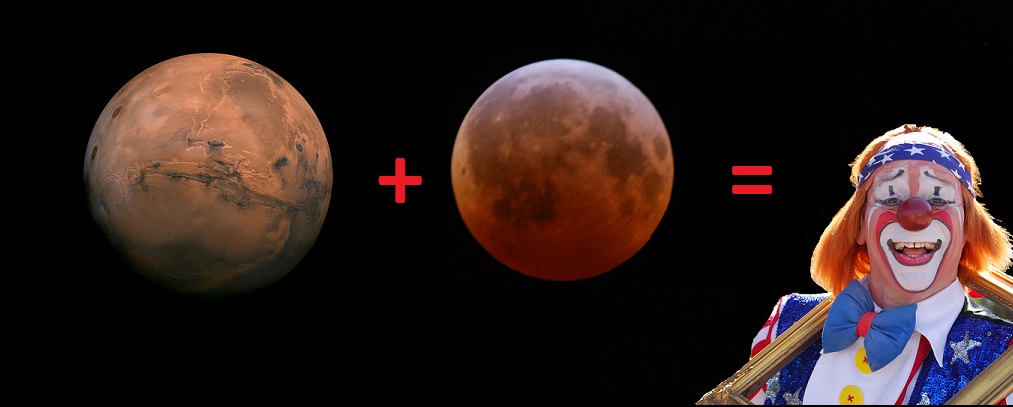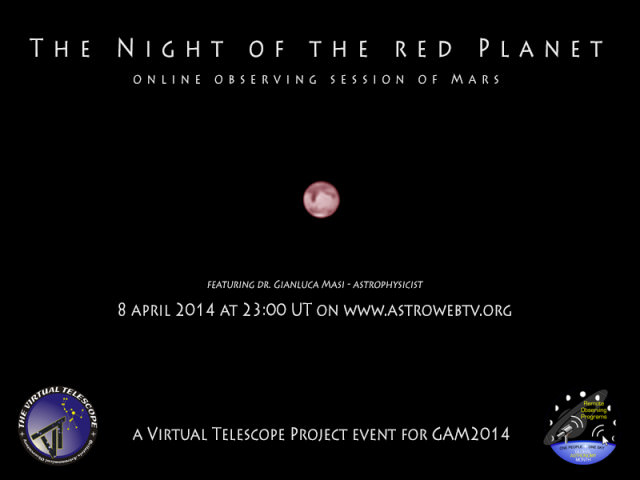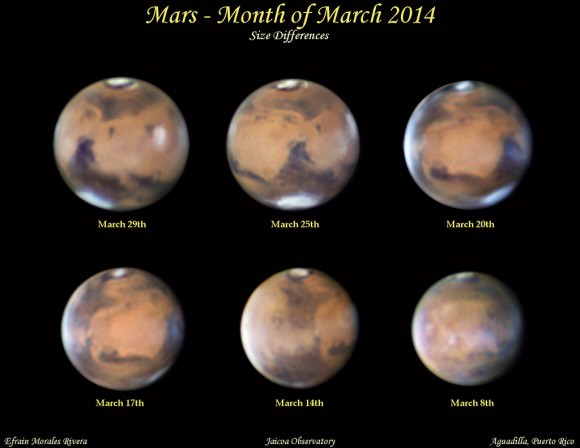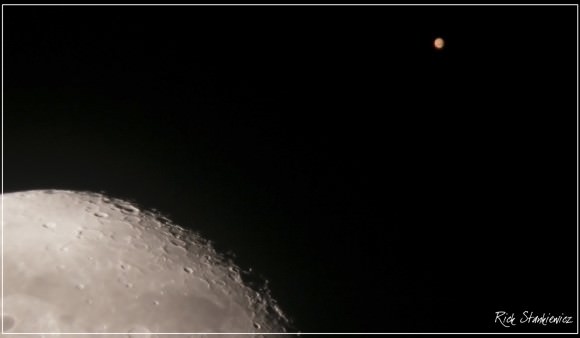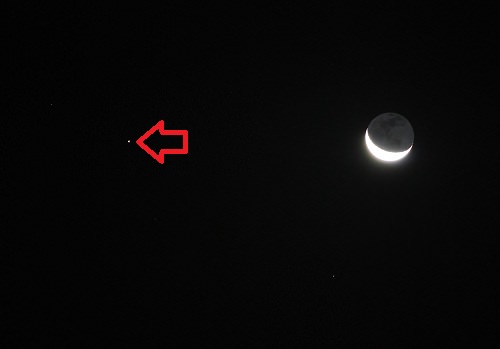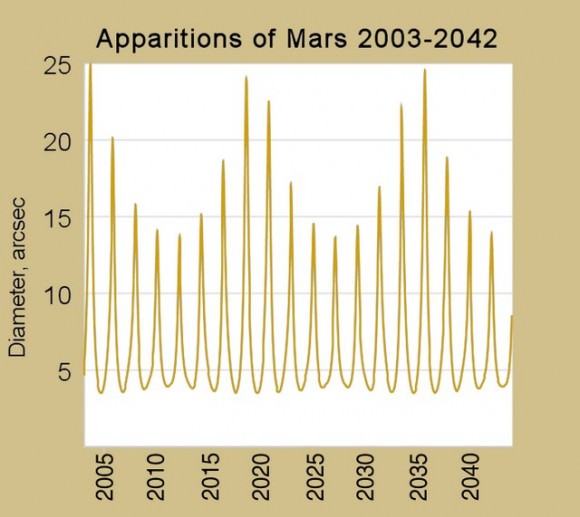We can finally reveal the truth.
A massive conspiracy, spanning over a decade, has been revealed at last by basement bloggers, YouTubers and Facebook users everywhere, implicating ‘big-NASA’ and the powers that be in a massive cover-up.
Yes, it’s the month of August once again, and the Red Planet Mars is set to appear ‘larger than a Full Moon’ over the skies of Earth, as it apparently does now… every year.
Um, no. Stop. Just… stop.
Sure, by now, you’ve had the hoax forwarded to you by that certain well-meaning, but astronomically uninformed family member/co-worker/anonymous person on Facebook.
What’s new under the Sun concerning the August Mars Hoax? To see where the hoax was born, we have to journey all the way back to the close opposition of Mars on August 27th, 2003. Hey, we actually took two weeks leave in the Fall of 2003 just to sketch and image Mars each night from our backyard lair in the Sonoran desert south of Tucson, Arizona from the then known Very Small Optical Observatory. Those were the days. We measured dial-up internet speeds in kbit/s, ‘burned CDs,’ and Facebook and Twitter were still some years away. Even spam e-mail was still sorta hip.
Two years later in 2005, we were all amused, as the ‘August Mars Hoax’ chain email made its first post-2003 appearance in our collective inboxes. Heck, we were even eager in those halcyon days to take to the nascent web, and do that new hipster thing known as ‘blogging’ to explain just exactly why this couldn’t be so to the masses.
Later in 2006, 2007, and 2008, it wasn’t so funny.
The Mars Hoax just wouldn’t die. “One more unto the breach,” the collective astro-blogging community sighed, as we all dusted off last year’s post explaining how the Red Planet could never approach our own fair world so closely.
It. Just. Couldn’t. Because orbital mechanics. Because physics.
Even the advent of social media couldn’t kill in annual onslaught of the Mars Hoax, and over a Spiderman movie reboot later, we’re now seeing it shared across Facebook, Twitter and more.
Sure, the Mars Hoax is as fake as Donald Trump’s hair. If there’s any true science lesson to learn here, it’s perhaps the mildly interesting social science study of just how the Mars hoax weathers the lean months of winter, to reemerge every August.
Here’s the skinny (again!) on just why Mars can’t appear as large as the Full Moon:
-The Moon is 3,474 kilometers in diameter, and orbits the Earth at an average distance of just under 400,000 kilometers.
-At this distance, the Moon can only appear about 30’ (half a degree) across.
-Think that’s a lot? Well, you could ring the 360 degree circle of the local horizon with 720 Full Moons.
-Mars, like the Earth, orbits the Sun. Even with Earth at aphelion (its most distant point) and Mars at perihelion, we’re still 206.7 – 151.9 = 54.8 million km apart. Sure, aphelion and perihelion of our respective worlds don’t quite line up in our current epochs, but we’ll indulge imagination and fudge things a bit.
-Though Mars is just over 2x times larger in diameter than the Moon, it’s also more than 143 times farther away, even at its said hypothetical closest.
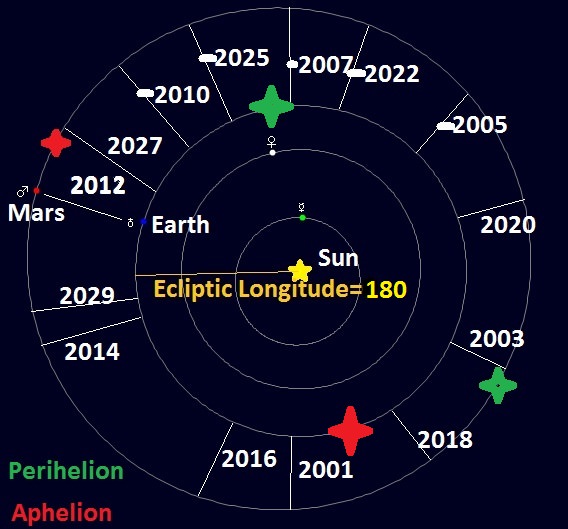
-Still want to see Mars as big as a Full Moon? Perhaps one day, astronauts will, though they’ll have to be orbiting just over a 800,000 km from the Red Planet to do it.
If we sound a little pessimistic in our characterizing the Mars Hoax as a recurring non-story, it’s because we see many truly fantastic things in space news that get far from their far shake. Real stories, of collapsing stars, rogue exoplanets, and intrepid rovers exploring distant worlds. Tales of humanoids, exploring space and doing the very best and noble things humanoids as a species can do.
Want to trace the history the Mars Hoax?
Here’s the saga of Universe Today’s coverage of all things ‘Mars Hoax’ since those olden days of the early web:
2005- No, Mars Won’t Look as Big as the Moon
2006- No, Mars Won’t Look as Big as the Moon in August
2007- Will Mars Look as Big as the Moon on August 27? Nope
2008- Please (Again) – Mars Will NOT Look as Big as the Full Moon
2009- Mars Will NOT Look as Big as the Full Moon… But You Can Watch it Get Closer
2010- Tonight’s the Night Mars Will NOT Look as Big as the Full Moon
2011- Is the Moon Mars Myth Over?
2013- The Cyber Myth that Just Won’t Die
2016- ????
Hey, it looks like the hoax did take a break in 2012 and 2014, so that’s encouraging at least…
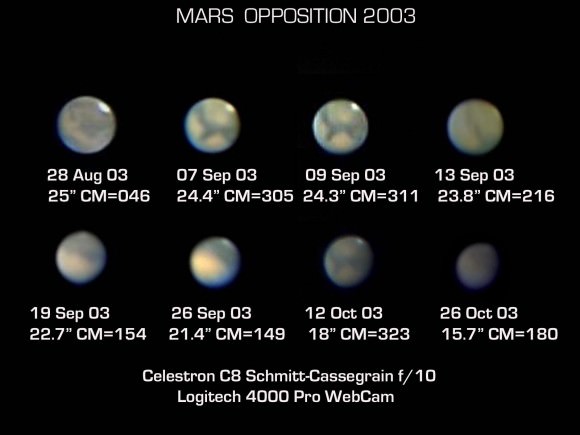
Now, I’m going to do my best to truly terrify all of science blogger-dom, and leave you with one final thought to consider. Mars reaches opposition (otherwise known in astronomical circles as ‘when it’s really nearest to the Earth’) once roughly every 26 months. All oppositions of Mars are not created equal, owing mostly to the eccentric orbit of the Red Planet. We have another fine opposition of Mars coming right up next year on May 22nd, 2016, followed by one that’s very nearly as favorable as the historic 2003 opposition in 2018, falling juuuuust shy of August on July 28th of that year…
Will the Mars Hoax meme find a new unwitting audience, and with it, new life?
Sleep tight…. we’ll be covering real science stories in the meantime, ’til we’re called to do battle with the Mars Hoax once again.

